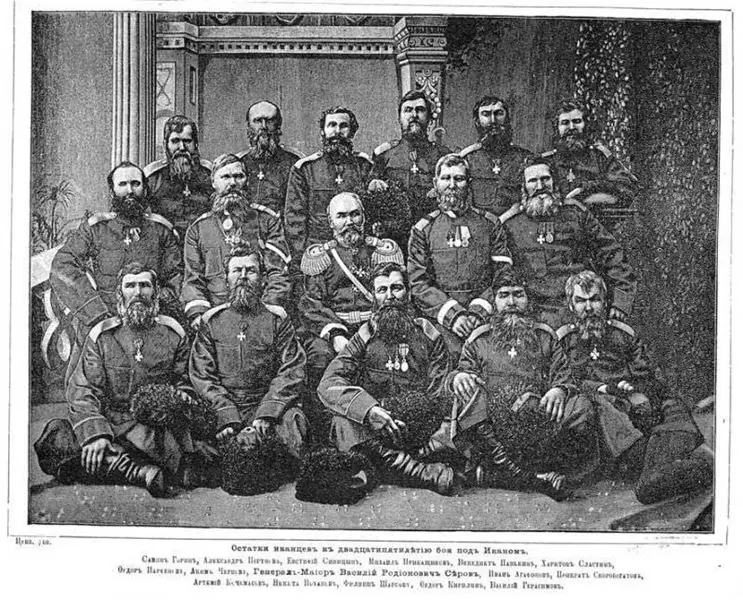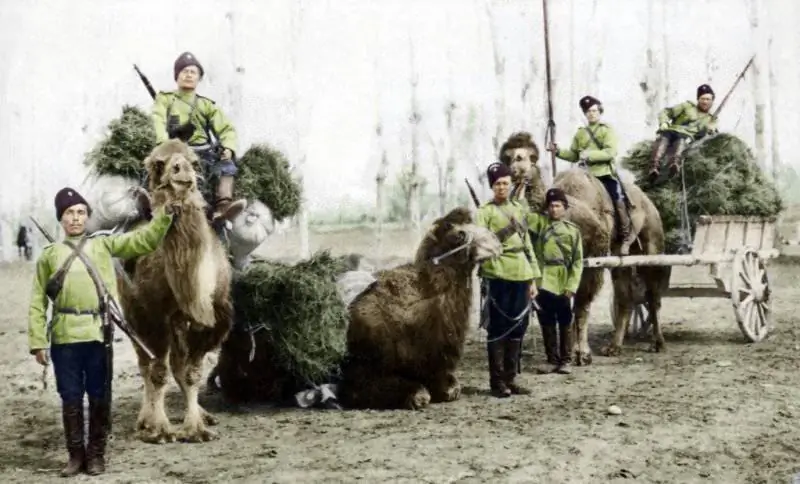- Author Matthew Elmers [email protected].
- Public 2023-12-16 21:49.
- Last modified 2025-01-24 09:17.
In 1853, Russian troops under the command of General Perovsky, having walked 900 miles across waterless terrain, stormed the Kokand fortress Ak-Mechet, which covered all the routes to Central Asia. Three hundred Ural and two hundred Orenburg Cossacks took part in the campaign. The fortress was renamed into Fort Perovsky and the construction of the Syr-Darya line began, which was supposed to cover the territory from the Aral Sea to the Lower Urals from raids. In 1856, the construction of fortifications began from Fort Perovsky to Fort Verny, in order to cover 900 versts of the steppe and connect the Syr-Darya line and the Siberian, to establish communication between the Siberian, Ural and Orenburg troops, which now had to protect an area of 3,500 versts. In 1860 the Kokand troops tried to capture Verny, but the Siberian and Semirechye Cossacks repulsed this attack. In 1864 Russian troops occupied Chimkent and defeated the Kokand people. The Kokand people gather the rest of their forces and go on a raid on the Russian troops in the Turkestan fortress, but on the way they stumble upon a hundred of the Ural Cossacks, Esaul Serov. In a three-day battle at Ikan, the Cossacks beat off the attack of the entire Kokand army. Of the 110 Cossacks, 11 survived, 47 were wounded, 52 were killed.

In 1865, Russian troops, together with the Ural Cossacks, occupied Tashkent. Turkestan region is established. In 1866, hostilities began against the emir of Bukhara claiming to Tashkent. The Bukharian raid was repulsed. In 1868, the Russian troops of General Kaufman, which include the Ural Cossacks, went to Samarkand, and the Bukhara Emir surrendered, recognizing the protectorate of Russia.

Orenburg Cossacks during the conquest of Turkestan
In 1869 Russian troops from Transcaucasia landed on the eastern coast of the Caspian Sea. In 1873 a campaign was organized against Khiva, the largest center of the slave trade in Central Asia. Through the waterless desert, the troops approach Khiva from three sides - from Turkestan, from the Orenburg line and from the Caspian coast. The Siberian and Semirechye Cossacks, 5 hundred Urals, 12 hundred Orenburg residents, the Kizlyar-Grebensky and Sunzhensky-Vladikavkaz regiments from the Terek and even a part of the Yeisk regiment of the Kuban army participate in the campaign. During the campaign, nature itself was defeated. Then Khiva was taken by storm on May 28 and 29. In 1875 the Orenburg, Ural, Siberian and Semirechye Cossacks helped the Russian troops to capture Kokand.
Turkestan and the Trans-Caspian region, where Russian power is consolidating, are divided by the Turkmen steppe, whose nomadic population continues to raid. Before the oasis, where the stronghold of the Turkmens - Geok-Tepe, stood, there was a desert for 500 versts. In 1877 and 1879. Russian troops twice unsuccessfully tried to occupy this fortress. In 1880 General Skobelev began a campaign against Geok-Tepe from the Caspian coast. Together with him are the 1st Labinsky, 1st Poltava and 1st Taman regiments of the Kuban Cossack army. A detachment of General Kuropatkin, which includes the Orenburg and Ural Cossacks, is moving towards Skobelev from Turkestan. The detachments meet at Geok-Tepe. The siege of the fortress begins on December 23, 1880, and on January 12, 1881, it is taken by storm. For this battle, the 1st Taman regiment of the Kuban was awarded the St. George banner. Thus, all of Central Asia was annexed to Russia.






